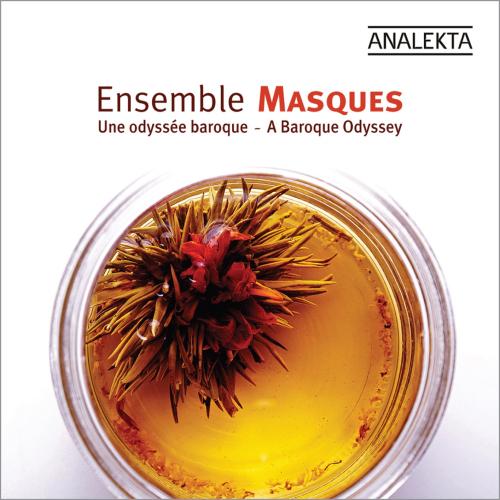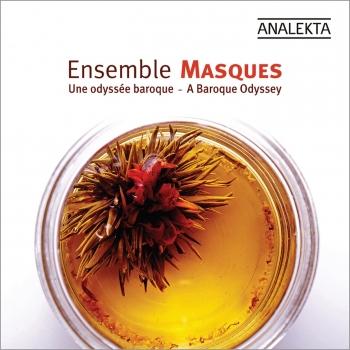
A Baroque Odyssey Ensemble Masques
Album Info
Album Veröffentlichung:
2008
HRA-Veröffentlichung:
16.01.2020
Label: Analekta
Genre: Classical
Subgenre: Chamber Music
Interpret: Ensemble Masques
Komponist: Johann Sebastian Bach (1685-1750), Henry Purcell (1659-1695), Georg Philipp Telemann (1681-1767), Antonio Vivaldi (1678-1741)
Das Album enthält Albumcover
- Georg Telemann (1681 - 1767): Overture In G Minor:
- 1 Overture In G Minor / Ouverture 01:24
- 2 Overture In G Minor / Air 04:36
- 3 Overture In G Minor / Loure 03:27
- 4 Overture In G Minor / Passepied 04:15
- Henry Purcell (1659 - 1695): The Fairy Queen, Semi-Opera, Z. 629:
- 5 The Fairy Queen, Semi-Opera, Z. 629 / First Music: Prelude 02:14
- 6 The Fairy Queen, Semi-Opera, Z. 629 / First Music: Hornpipe 01:45
- 7 The Fairy Queen, Semi-Opera, Z. 629 / Second Music: Aire 01:03
- 8 The Fairy Queen, Semi-Opera, Z. 629 / Second Music: Rondeau 00:57
- Antonio Vivaldi (1678 - 1741): Concerto Op. 10 No. 2 In G Minor, "La Notte" RV 439:
- 9 Concerto Op. 10 No. 2 In G Minor, "La Notte" RV 439 / Largo 01:22
- 10 Concerto Op. 10 No. 2 In G Minor, "La Notte" RV 439 / Presto (Fantasmi) - Largo 01:35
- 11 Concerto Op. 10 No. 2 In G Minor, "La Notte" RV 439 / Presto 01:44
- 12 Concerto Op. 10 No. 2 In G Minor, "La Notte" RV 439 / Largo (Il Sonno) 01:05
- 13 Concerto Op. 10 No. 2 In G Minor, "La Notte" RV 439 / Allegro 01:28
- Traditional: Ouverture In F Major:
- 14 Ouverture In F Major 02:17
- Traditional: Fantaisie "Les Pleurs D’Orphée Aillant Perdu Sa Femme":
- 15 Fantaisie "Les Pleurs D’Orphée Aillant Perdu Sa Femme" 03:00
- J.S. Bach (1685 - 1750): Excerpt From Harpsichord Concerto In F Minor, Bwv 1056:
- 16 Excerpt From Harpsichord Concerto In F Minor, Bwv 1056 / Largo 03:32
- Georg Telemann: Suite In A Minor For Recorder (Excerpts) TWV 55:A2
- 17 Suite In A Minor For Recorder (Excerpts) TWV 55:A2 / Ouverture 06:25
- 18 Suite In A Minor For Recorder (Excerpts) TWV 55:A2 / Réjouissance 02:29
- 19 Suite In A Minor For Recorder (Excerpts) TWV 55:A2 / Polonaise 03:24
- Henry Purcell: The Fairy Queen, Semi-Opera, Z. 629 / Act V:
- 20 The Fairy Queen, Semi-Opera, Z. 629 / Act V: Chaconne – Dance For Chinese Man And Woman 02:48
Info zu A Baroque Odyssey
Habits of the Soul: If one assumes rhetoric (i.e., persuasion) as the foundation of the Baroque musical edifice, irrespective of country—and in particular of the secular music this recording documents—one might then place atop it the columns and arches of dance and song-based instrumental fantasy, onto which could be applied extravagant swirls and ornamentation. Indeed, dance makes up this disc’s primary focus, though granted it is dance in its most disembodied form since there is not the remotest hint of dancers here. It remains to be seen whether rhythm alone can make up for their absence, but we remain convinced (and believe the listener will agree) that the persuasive art of the instrumentalists will overcome the distance imposed by the audio-only format. The other focus of the disc is instrumental fantasy, either as a tributary of dance or freed from it completely.
This fantasy would seem to be above all an Italian affair, since vocal melody and virtuosity was, for them, from at least the early 17th century onward, the driving force behind musical expression, as attested to by the arrival, with Monteverdi, of the seconda pratica, which gave monody and basso continuo supremacy over polyphony. This led to a propensity for contrast and surprise, in the manner of the unpredictable moods so common in Italian opera (though one might argue that this was simply an extension of the Italian character). Antonio Vivaldi (1678–1741) was one of the worthiest inheritors of this style; his operas were performed throughout Europe, and the instrumental works he composed for the talented orphans at Ospedale della Pietà were magnificent tours de force. The Concerto Op. 10 No. 2 in G minor, “La notte,” played here on transverse flute, is a fine example, where “the night” of the title evokes both the phantasmagorical nature of dreams and the abandon of sleep.
It is easy to imagine French instrumentalists as being less extroverted in their playing than their Italian counterparts, but in truth, the French were exposed to the verve of Italian musicians working at the French court throughout the 16th century, before they returned home in the 1590s, underpaid and tired of the endless civil wars. Later, between 1610 and 1620, the Vingt-quatre violons du roi were formed, a homogenous ensemble whose members were nevertheless all composers to some extent and who could improvise and bring their performances of dance music to life with doubles and virtuoso diminutions. They endowed their ballets and suites with a certain breadth and variety, and they laid the foundations of the French overture before the form was later fixed by Lully, whose imperious reign over French music many viewed as restrictive. Italians were later brought back, this time at the opera, by Cardinal Mazarin, for the sumptuous performance in 1647 of Orfeo by Luigi Rossi (ca. 1597–1653), but this caused a revolt, and after the cardinal’s death in 1661, this type of Franco-Italian collaboration was no longer possible.
The wide influence of the French dance, as performed by the Vingt-quatre violins and represented on this recording by Gillaume Dumanoir (1615–1697), can be seen in the Kassel manuscript, written for the court of the Landgrave of Hesse between 1650 and 1670 and brought to light by the musicologist Jules Ecorcheville in 1906. Dumanoir was a member of the “Violons” before becoming the ensemble’s director in 1655 and two years later “King and master of minstrels” of all of France. This put him in charge of instrumentalists everywhere, as well as of dance masters. Then, in what was effectively a corporate schism, the Académie de danse was created in 1661, in opposition to Dumanoir’s authority. Dumanoir responded to the breakaway group with a 1664 publication entitled Mariage de la musique avec la dance. In it, the author stressed the dependence of dance upon music, in opposition to the position of the “académistes.” “Dance,” he wrote, “is not an art per se, but merely an exercise.” Many felt the contrary, however, including Louis XIV himself along with the well-known Jesuit monk Claude-François Menestrier, who noted in his 1682 work Des Ballets anciens et modernes selon les règles du theater that “ballet not only imitates actions; according to Aristotle it imitates passions and habits, which is more difficult than the expression of actions. This imitation of habits and the soul’s affections is based on the imprints that the soul makes naturally upon the body, and on the judgments that we make of people’s habits and inclinations on these interior movements.” He also states that “the ballet expresses movements that painting and sculpture cannot express and, through these movements, expresses the very nature of things and habits of the soul that can only reach the senses through movement.” What better description of the power of dance!
The “British Orpheus,” Henry Purcell (1659–1695), was only eighteen when he was appointed composer for the court violins, a string ensemble created by Charles II on the model of France’s Vingt-quatre violons. Purcell’s The Fairy Queen, written in 1692 and freely adapted from Shakespeare’s A Midsummer Night’s Dream, is considered a semi-opera, a genre that gave back an English flavour to theatrical works by combining classics of the dramatic repertoire with airs and dances on borrowed but newly composed situations. These productions were influenced by the sumptuousness of Italian opera and the innovations of Lully’s lyric tragedies. The instrumental music, from curtain tunes to danced airs and interludes, also mix Italian idioms with typically French and English traditions.
It has already been seen how the French style spread to the Germanic countries, and it, along with the flamboyant Italian concertato style would flourish there. One of the most beloved composers of his day, Georg Philipp Telemann (1681–1767), was a master of this fortunate mixing of styles, especially in his numerous “overtures” (the name the Germans gave to the suite). The suite for recorder, excerpts of which are presented here, is one of some 135 that survive of the over 1000 suites he apparently composed. Less well-known, Johann Bernhard Bach (1676–1749) was Johann Sebastian’s cousin. An active harpsichordist and organist in Eisenach, it was written about him in his day that he “composed many beautiful overtures, arranged in the manner of Telemann.” The orchestral suite presented here is a fine example, drawing, as did Telemann, from both rival “tastes”: French and Italian. “In the end,” writes Nikolaus Harnoncourt, “the cultural conflict (between the French and Italian styles) was enriching: from it was born what is known as les goûts réunis (or the fusion of styles) which became characteristic of German 18th century music. The great composers wrote French suites, Italian sonatas and concertos, but always integrating in them some element borrowed from the enemy, and local tradition acted in this fusion as the catalyst.”
So we might take pleasure in imagining—in all this music, most of which is imbued with or inspired by dance—a complete symbiosis of harmony and rhythm. In this way it may be transformed in the mind—as Father Menestrier suggested—into meaning-steeped movement, revealed by the rhetoric of the musicians performing it.
Ensemble Masques
Ensemble Masques
Masques is a Montreal-based early music ensemble founded in 1998, performing vocal and instrumental music of the 17th and 18th centuries. The name of the ensemble is inspired by the masques of the Elizabethan England—mystical performances which fused poetry, music, dance and drama. The ensemble has become a meeting point for Canada’s young musicians. Masques also collaborates regularly with up and coming European talents, thereby maintaining close ties with musicians of diverse backgrounds. All the musicians of Masques have enviable performing experience, and regularly concertize as soloists and chamber musicians throughout Canada, the United States and Europe with such ensembles as Capriccio Stravagante, Tafelmusik, La Petite Bande and Les Voix Humaines. While maintaining a core ensemble, Masques varies in size according to the demands of the projects it presents.
The ensemble has risen rapidly to international attention, winning the Grand Prize in the Dorian/Early Music America Competition in 2000, and being selected as finalist at the York Early Music Competition in 2001. Following the release of the ensemble’s first recording, devoted to the Consorts in Two Parts by the English composer Matthew Locke, Masques has been heard coast to coast in various festivals including Lamèque, Lanaudière and Vancouver. Masques was also heard in France and in the United States. The ensemble’s performances are regularly broadcast on CBC/Radio-Canada.
Olivier Fortin
Founder and director of the Montreal-based early music ensemble Masques, Olivier Fortin graduated with distinction from the Québec Conservatory in 1995. He continued his training with Dom André Laberge, obtained a Master Degree from University of Montreal under the direction of Prof. Réjean Poirier, and received several scholarships for studies in Paris with Pierre Hantai and in Amsterdam with Bob van Asperen. In 1997 he was awarded top prizes at the Montreal Bach Competition and the Bruges Festival. He is increasingly esteemed as a soloist and chamber musician, touring and recording throughout Europe, the United States and Canada with ensembles such as Masques, Capriccio Stravagante, Tafelmusik, Chanticleer, the Studio de Musique Ancienne de Montréal and Les Voix Humaines as well as playing with Skip Sempé and Pierre Hantaï in a harpsichord trio. Olivier Fortin teaches harpsichord and chamber music at the Conservatoire de Musique de Quebec.
Dieses Album enthält kein Booklet









